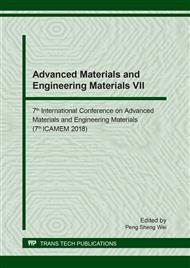p.145
p.150
p.158
p.163
p.168
p.173
p.178
p.183
p.190
Calcium Carbonate Reinforced Polypropylene Nanocomposites: Effect of Nano-Filler Loadings on the Melt Rheological Properties
Abstract:
In recent years, polymer-based nanocomposites have been investigated by many researchers due to their enhanced properties. Different types of nanomaterials have been used to produce polymer nanocomposites. One of them is nano-CaCO3. In the present work, nano-CaCO3 material reinforced polypropylene (PP) nanocomposites have been fabricated by melt compounding the PP pellets and nano-CaCO3 masterbatch. The effect of four different loadings of nano-CaCO3 (0, 5, 10, 15 wt%) on the melt rheological properties of the nanocomposites has been investigated. The morphology of the nanocomposites was analyzed by a Field Emission Scanning Electron Microscopy (FESEM) to study the dispersion state and distribution of nanoCaCO3 particles in PP matrix. Whereas, the melt rheological behavior of the nanocomposites was analyzed by an oscillatory rheometer. The FESEM micrographs showed that the nano-CaCO3 particles were well dispersed and distributed in the PP matrix. Additionally, the melt rheological analysis results showed that the complex viscosity of all nanocomposites samples were higher than that of neat PP and increased with increasing nano-CaCO3 loadings. Furthermore, the complex viscosity data from the rheological test has been fitted by Carreau-Yasuda equation and it was found to be well fitted.
Info:
Periodical:
Pages:
168-172
Citation:
Online since:
August 2018
Keywords:
Price:
Сopyright:
© 2018 Trans Tech Publications Ltd. All Rights Reserved
Share:
Citation:


